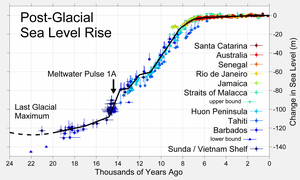From Wikipedia, the free encyclopedia

The history of Greenland, the world's largest island, is the history of life under extreme Arctic conditions: an ice cap covers about 95 percent of the island, largely restricting human activity to the coasts.
The first humans are thought to have arrived around 2500 BC. This group apparently died out and were succeeded by several other groups migrating from continental North America. To Europeans, Greenland was unknown until the 10th century, when Icelandic Vikings settled on the southwestern coast. This part of Greenland was apparently unpopulated at the time when the Vikings arrived; the direct ancestors of the modern Inuit Greenlanders are not thought to have arrived until around AD 1200 from the northwest. The Norse settlements along the southwestern coast eventually disappeared after about 500 years. The Inuit thrived in the icy world of the Little Ice Age and were the only inhabitants of the island for several centuries. Denmark-Norway nonetheless claimed the territory, and, after centuries of no contact between the Norse Greenlanders and their Scandinavian brethren, it was feared that the Greenlanders had lapsed back into paganism; so a missionary expedition was sent out to reinstate Christianity in 1721. However, since none of the lost Norse Greenlanders were found, Denmark-Norway instead proceeded to baptize the local Inuit Greenlanders and develop trading colonies along the coast as part of its aspirations as a colonial power. Colonial privileges were retained, such as trade monopoly.
During World War II, Greenland became effectively detached, socially and economically, from Denmark and became more connected to the United States and Canada. After the war, control was returned to Denmark, and, in 1953, the colonial status was transformed into that of an overseas amt (county). Although Greenland is still a part of the Kingdom of Denmark, it has enjoyed home rule since 1979. In 1985, the island became the only territory to leave the European Union, which it had joined as a part of Denmark in 1973.
Read More...

The history of Greenland, the world's largest island, is the history of life under extreme Arctic conditions: an ice cap covers about 95 percent of the island, largely restricting human activity to the coasts.
The first humans are thought to have arrived around 2500 BC. This group apparently died out and were succeeded by several other groups migrating from continental North America. To Europeans, Greenland was unknown until the 10th century, when Icelandic Vikings settled on the southwestern coast. This part of Greenland was apparently unpopulated at the time when the Vikings arrived; the direct ancestors of the modern Inuit Greenlanders are not thought to have arrived until around AD 1200 from the northwest. The Norse settlements along the southwestern coast eventually disappeared after about 500 years. The Inuit thrived in the icy world of the Little Ice Age and were the only inhabitants of the island for several centuries. Denmark-Norway nonetheless claimed the territory, and, after centuries of no contact between the Norse Greenlanders and their Scandinavian brethren, it was feared that the Greenlanders had lapsed back into paganism; so a missionary expedition was sent out to reinstate Christianity in 1721. However, since none of the lost Norse Greenlanders were found, Denmark-Norway instead proceeded to baptize the local Inuit Greenlanders and develop trading colonies along the coast as part of its aspirations as a colonial power. Colonial privileges were retained, such as trade monopoly.
During World War II, Greenland became effectively detached, socially and economically, from Denmark and became more connected to the United States and Canada. After the war, control was returned to Denmark, and, in 1953, the colonial status was transformed into that of an overseas amt (county). Although Greenland is still a part of the Kingdom of Denmark, it has enjoyed home rule since 1979. In 1985, the island became the only territory to leave the European Union, which it had joined as a part of Denmark in 1973.








